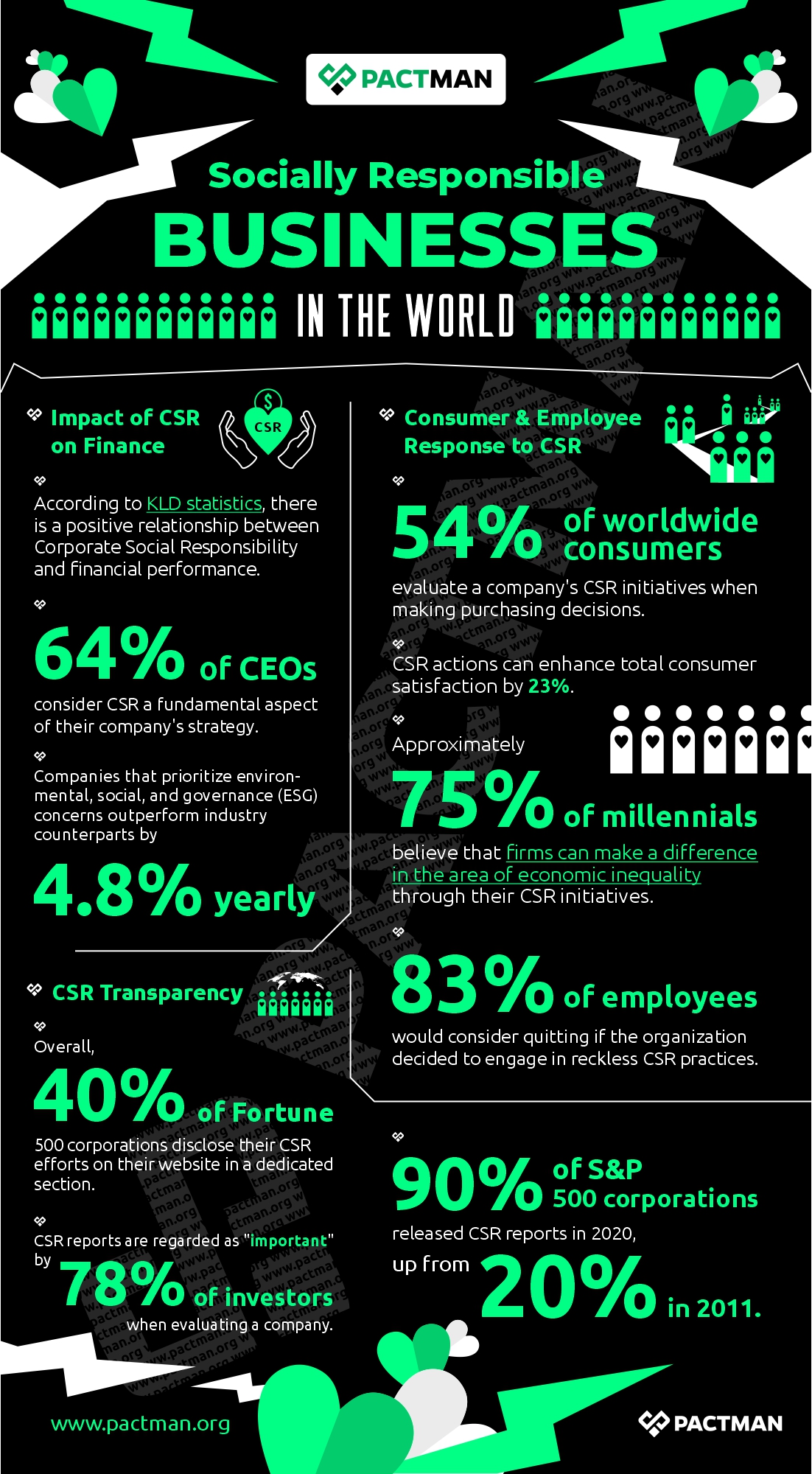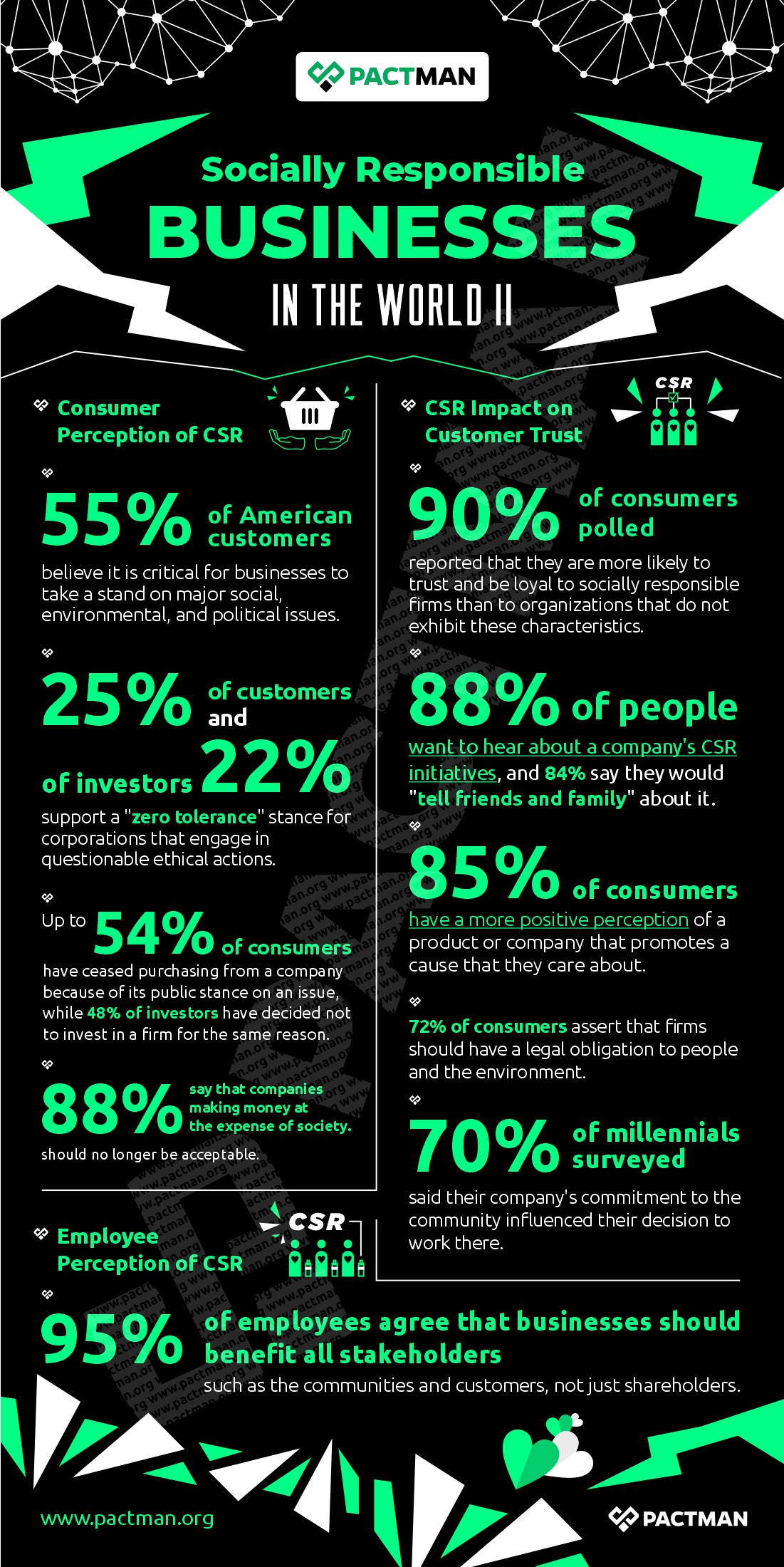I
Introduction
According to socially responsible principles, businesses are bound by a social contract to society. As we all know, business activities tend to have an impact on the external environment. Hence, there is a rising demand that one of the duties of accounting should be to report on an organization’s impact in this regard.

As earlier stated, the activities of a business will have an impact not only on itself but also on the external environment in which it operates. As a result, there is a need to examine the business environment in which the firm operates, the local sociocultural environment of the firm, and the larger global environment when considering a company’s external impact.
Over the years, there has been an increase in the number of companies adopting corporate social responsibility (CSR) initiatives. Also, reports have shown that socially responsible businesses tend to record significant success as the initiative provides a strategic advantage. Hence, it is best to adopt CSR policies as it enables businesses to prioritize their social environment.
II
Practical Definitions of CSR and Socially Responsible Businesses
When defining corporate social responsibility, it is best to consider the link that exists – or should exist – between multinational firms, national governments, and individual citizens. Locally, CSR is concerned with the relationship that exists between a corporation and the community in which it resides or operates. Also, CSR can be defined based on a corporation’s connection with its stakeholders.
However, Investopedia provides a simple yet detailed definition. “Corporate social responsibility is a business model by which companies make a concerted effort to operate in ways that enhance rather than degrade society and the environment.”

By and large, all CSR effort is guided by three fundamental concepts: Sustainability, Accountability, and Transparency.
a. Sustainability
Sustainability is concerned with the impact that current activity has on the possibilities accessible in the future. This posits that resources used in the present may no longer be available for use in the future. It is especially concerning when the resources are limited in quantity. As a result, sustainability requires society to use no more of a resource than can be replenished.
The paper business, for example, is known for its sustainable policy of replanting trees to replace the harvested ones. For the most part, this can help maintain expenses in the present.
When considering an organization as part of a larger social and economic system, there is a need to consider these consequences. This helps to evaluate not just the costs and value created in the present but also helps to ensure the future of the firm itself. Sustainability measures evaluate the rate at which the business consumes resources in comparison to the rate at which resources may be regenerated.
Unsustainable operations can be accommodated by either building sustainable operations or planning for a future with fewer resources than are currently necessary. In practice, most organizations strive for reduced unsustainability by increasing resource efficiency.
b. Accountability
Accountability is concerned with a firm recognizing that its acts have an impact on the outside world. As a result, the business is willing to accept responsibility for the consequences of those actions.
Firstly, this concept requires a quantification of the repercussions of activities made both internally and externally. More importantly, the concept suggests that quantification be reported to all parties who are impacted by those acts. This entails reporting to external stakeholders about the effects of the firm’s actions and how they affect those stakeholders.
By and large, this concept implies that the business is part of a larger societal network. Hence, it has responsibilities to the entire network rather than just the organization’s owners.
Accountability demands the formulation of suitable metrics for environmental performance as well as adequate reporting of the firm’s actions.
c. Transparency
Transparency, as a principle, indicates that the external consequence of a firm’s actions can be determined from its reporting. Likewise, essential facts are not concealed within that reporting. Thus, given the information provided by the organization’s reporting procedures, all of the repercussions of the organization’s actions, including external impacts, should be obvious to all.
Transparency is especially important for external consumers of such information since they lack the underlying details and knowledge that internal users have.
Transparency can thus be seen to follow from the other two principles. Also, it is seen as part of the process of the organization accepting responsibility for the external effects of its actions while transferring power to external stakeholders.
As seen above, CSR is a broad topic that generates a wide range of viewpoints and may be approached in a variety of ways.
III
Critical Statistics on Socially Responsible Businesses
In this section, we will consider critical statistics that show the impact of social responsibility on businesses.
a. Impact of CSR on Finance
According to KLD statistics, there is a positive relationship between Corporate Social Responsibility and financial performance. Also, 64% of CEOs consider CSR a fundamental aspect of their company’s strategy. Companies that prioritize environmental, social, and governance (ESG) concerns outperform industry counterparts by 4.8% yearly.

b. Consumer and Employee Response to CSR
54% of worldwide consumers evaluate a company’s CSR initiatives when making purchasing decisions. Likewise, CSR actions can enhance total consumer satisfaction by 23%. Approximately 75% of millennials believe that firms can make a difference in the area of economic inequality through their CSR initiatives.
83% of employees would consider quitting if the organization decided to engage in reckless CSR practices. In addition, 95% of employees agree that businesses should benefit all stakeholders such as the communities and customers, not just shareholders.
c. CSR Transparency
Overall, 40% of Fortune 500 corporations disclose their CSR efforts on their website in a dedicated section. Also, CSR reports are regarded as “important” by 78% of investors when evaluating a company. Hence, 90% of S&P 500 corporations released CSR reports in 2020, up from 20% in 2011.

d. Consumer Perception of CSR
55% of American customers believe businesses must take a stand on major social, environmental, and political issues. Likewise, 25% of customers and 22% of investors support a “zero tolerance” stance for corporations that engage in questionable ethical actions.
Up to 54% of consumers have ceased purchasing from a company because of its public stance on an issue, while 48% of investors have decided not to invest in a firm for the same reason. Also, 88% say that companies making money at the expense of society should no longer be acceptable.
e. CSR Impact on Customer Trust
90% of consumers polled reported that they are more likely to trust and be loyal to socially responsible firms than to organizations that do not exhibit these characteristics. Also, 88% of people want to hear about a company’s CSR initiatives, and 84% say they would “tell friends and family” about it.
85% of consumers have a more positive perception of a product or company that promotes a cause that they care about. In addition, 72% of consumers assert that firms should have a legal obligation to people and the environment.
70% of millennials surveyed said their company’s commitment to the community influenced their decision to work there.
IV
Top Benefits of Corporate Social Responsibility
Companies can profit from CSR in the following ways:

1. Financial benefits:
Socially responsible companies make money while also contributing to specific aspects of social development. Also, these businesses tend to make their products and services more appealing to the general public thereby creating more profitability for the firm. CSR will certainly incur additional expenditures. However, the benefits always surpass the costs.
2. Risk management:
By engaging in social responsibility initiatives, the corporation can limit and neutralize the risk associated with numerous scandals involving corruption and accidental causes in the environment.
3. Human resources:
Also, socially responsible initiatives are a great way to attract and maintain employees in a firm. Likewise, putting this action into practice helps to enhance the company’s working environment, and promotes employee productivity and motivation, as well as their devotion to the firm. In addition, it helps to boost the company’s reputation thereby contributing to the retention of high-quality employees.
4. Brand differentiation:
By embracing the concept of CSR, the corporation adopts ethical and moral values in its operations. As a result, its market reputation and market share grow as consumers increasingly choose and purchase the products and services of socially responsible businesses.
Essentially, CSR initiatives can contribute to improving a firm’s sales, establishing loyal customers, developing a company brand, and distinguishing the company from its competitors in the minds of customers.
5. License to operate:
By adopting various voluntary initiatives, companies can persuade governments and the general public that they take health, safety, diversity, and the environment seriously. Also, it provides a great way for companies to avoid legal problems. This is because CSR initiatives ensure compliance with numerous existing regulatory standards in the country.
V
Characteristics of Socially Responsible Businesses
Corporate social responsibility (CSR) is increasingly gaining traction as a corporate strategy. Likewise, companies should have a clear structure for conducting CSR activities.
CSR initiatives can be used to address consumers’ social problems and build a positive business image. In addition, companies can foster beneficial relationships with consumers and other stakeholders. By and large, the goal is to focus on how to relate with stakeholders effectively and to ensure that commercial activities have a positive impact on society.

In this section, we will consider some of the primary characteristics of socially responsible businesses.
1. Socially Responsible Businesses are known to Undertake Performance Evaluation and Performance Reporting
Companies must be willing and must have the ability to monitor, evaluate, and report on their performance. This is also true when considering CSR. However, measuring and evaluating performance can oftentimes become a challenging process.
To begin with, when determining performance standards, there is a need to consider the perspectives from which it is evaluated. Also, performance measurement requires suitably relevant measures based on the context being evaluated.
Management Today is known for its publication of the annual “Britain’s Most Admired Companies” survey. These metrics provide a reputation rating in nine categories based on ‘rivals’ perceptions. Afterward, these measures are combined to provide a total score. The nine groups are as follows:
- Quality of management;
- Quality of goods and services;
- Capacity to innovate;
- Quality of marketing;
- Ability to retain top talent;
- Community and environmental responsibility;
- Financial soundness;
- Value as a long-term investment;
- Use of corporate assets.
A company must first gain an awareness of the effects of its activities on the external environment before any relevant measures can be taken. Hence, the completion of an environmental audit is the starting point for the creation of such an understanding.
1.1 What is an environmental audit?
An environmental audit is simply an investigation and documentation of the firm’s actions. Such an audit will necessitate a thorough grasp of its procedures. This documentation is oftentimes lengthy and cannot be completed solely by the firm’s accountants. It will require the involvement of other specialists and managers inside the organization. Their knowledge and experience will need to be pooled to get a complete understanding of the firm’s activities.
The goal of such an audit is first to understand the impacts of organizational activity and then to be able to assign expenses to such activity. Also, it enables organizational managers to consider alternative methods of carrying out the various activities that comprise the firm’s operational processes. Companies can consider and evaluate the cost implications, as well as the benefits, of carrying out such processes differently.
Environmental auditing, like financial or systems auditing, must be performed regularly. This ensures that the company analyzes progress through a comparative analysis. This also helps to determine where further improvement may be made in light of present progress and changing operational practices.
2. Social Responsible Businesses Embrace Effective Leadership Management
For an organization to be socially responsible, its senior management must be committed. Effective change management will demand that leadership take the lead to initiate and drive the process. Also, understanding this leadership process can help a leader become a more effective manager.
By and large, those who are more concerned about connections than with the immediate accomplishment of the task at hand will want to involve their subordinates in the decision-making and planning process. In addition, those who are unconcerned about work completion or their relationship with their subordinates will delegate authority to them to choose when and how the task should be completed.
This may appear to be a sign of indifference. However, delegation (leaving the decision as to when and how to carry out a task) is the highest form of trust. This is because the manager retains responsibility for the task’s performance but cedes control of how it is carried out to others.
Furthermore, good leadership is dependent on the connection between the leader and the led. However, it is also dependent on other factors such as the circumstances. The leadership style required to lead a fresh new start-up business would most likely be significantly different from that required to lead a long-established but struggling organization. This, in turn, may be considerably different from the standard required to reorganize a business following a takeover. As a result, the demands of leadership are determined by the circumstances as well as the people involved.
Also, different leadership styles may be more effective in some cultures than others. As we all know, leadership is mostly concerned with dealing with people to maximize the outcome. Hence, every administrative effort involves people.
2.1 Leadership management should conduct an environmental analysis
Conducting an environmental analysis of the firm’s external environment enables a firm to build a strategic plan. Likewise, an evaluation of the internal environment will allow a company to convert this plan into a corporate strategy for implementation.
The leadership management is responsible for developing a firm’s CSR strategic plan. Overall, the strategic plan outlines the business’s future objectives and evaluates the options accessible to the business as well as its capabilities to accomplish this plan. Afterward, the plan is broken down into a more concrete process that can be described quantitatively.
3. Socially Responsible Businesses are known to Implement CSR Programs
Opinions on social responsibility as a business aim tend to vary greatly. While some people are opposed to any economic action that affects earnings, others believe that social duty must come first. Some critics are concerned that businesses would have too much control over how social projects are tackled by society as a whole, or that they will lack the knowledge required to address social issues.
However, the most acceptable belief is that companies should work to improve citizens’ lives because they are citizens themselves. Generally, they have tremendous resources and may contribute to the very issues that social programs address.
3.1 Managing Social Responsibility Programs
A complete commitment to social responsibility will demand a professionally planned and managed program. In addition, managers must be willing to take steps to promote a companywide sense of social responsibility.
Here are the steps on how to manage social responsibility programs.
a. Social responsibility must begin at the top and be incorporated into strategic planning. No program can flourish without the support of top management. Hence, management must take a clear stance on social responsibility and establish a policy statement articulating that commitment.
b. A committee of top managers must create a plan outlining the needed funds for CSR programs. Companies may set aside a percentage of profits for social projects or stipulate specific goals, such as supporting climate change.
c. The firm’s agenda must be overseen by a single executive. The chosen individual must monitor the program and oversee that its implementation aligns with the firm’s policy statement and strategic plan.
d. The firm must undertake social audits regularly. This ensures systematic examinations of its success in allocating cash for social responsibility goals.
Consider the following scenario: a company’s strategic plan demands a $200,000 investment in training 300 unemployed individuals and placing 275 of them in jobs.
Firstly, a social audit will certify the program’s effectiveness. This will prove whether the corporation has spent $198,000, trained 305 people, and filled 270 jobs at the end of a year. However, if the program costs $350,000, trains only 190 people, and places just 40 of them, the audit will show that the program is a failure.
A failure of this magnitude should trigger a reconsideration of the program’s implementation and priorities.
Conclusion
In summary, an organization’s operations can have a significant impact on its external environment and even contribute to its transformation. Not to mention, a firm’s popularity grows after it admits to flaws and takes steps to remedy them. By doing so, they demonstrate that honesty is the best policy and that customers are reasonable. Individual customers, according to the facts, are understanding and do not expect perfection, but do expect honesty and openness.
Furthermore, people want corporations to make attempts to improve their business behavior and tackle their CSR issues. Hence, it is acceptable to assert that the growing relevance of CSR is being driven by individuals who care. However, these persons are not just customers, but also employees, managers, owners, and firm investors.


